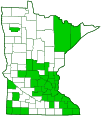eight-spotted forester moth
(Alypia octomaculata)
Conservation • Description • Habitat • Ecology • Distribution • Taxonomy
|
|
||||||||||||||||||
Description |
Eight-spotted forester moth is a distinctive, common, early season, medium-sized moth. It occurs in the United States and southern Canada from the East Coast to the Great Plains. It also occurs in northern Mexico. It is common in Minnesota. Adults are found from April to July at woodland edges and openings and at field edges. They feed on the nectar of a wide variety of flowers. Larvae feed on the leaves, tendrils, and growing stem tissue of grape (Vitis spp.), peppervine (Ampelopsis spp.), and Virginia creeper (Parthenocissus quinquefolia). Adults are ⅝″ to ¾″ (16 to 20 mm) in length and have a 1 3⁄16″ to 1 7⁄16″ (30 to 37 mm) wingspan. The forewing is black with two large, distinctive, pale yellow spots and five indistinct metallic blue lines. On fresh specimens it has a metallic blue sheen. The inner spot is in the basal half of the median area, the outer spot is in the outer half. The distance between the two spots is less than the width of the outer spot. There are two lines of metallic blue scales in the basal area, two lines between the spots, and one line in the postmedial area. The lines are only visible when reflecting light at just the right angle. The hindwing is black with a large white spot in the basal area and a smaller white spot at the outer edge of the median area. On the male the inner spot reaches the inner margin. On the female it is separated from the basal area by a black band. The eight spots on the wings are the source of both the common name and species epithet of this moth. On the male, there is a white longitudinal line on the upper side of the abdomen. Sometimes the line is represented by just a spot on the first and seventh abdominal segments. On both sexes there is a small pale yellow spot behind the head, and a prominent, pale yellow “shoulder stripe”, a tuft of hairs, on the appendage covering the base of each wing (tegula). The antennae are not ringed on either sex. The legs are black. On the front and middle legs there is a showy tuft of bright orange, hair-like scales on the third segment (femur). The mature caterpillar is up to 1¼″ (3 cm) long. The head and thoracic shield are orange with black spots. Each abdominal segment is white with up to eight narrow black bands. On the rear quarter of each segment there is a bright orange band with large and small black spots. Each large black spot has a long, stiff, white, bristle-like hair (seta). The orange bands are complete on abdominal segments one through three (A1 to A3) and on A8 but are limited to the sides of A4 to A7. At the base of each segment, below the breathing pores (spiracles), there is a white to cream-colored splotch. The splotch and orange band on A8 are the largest. |
Size |
Total length: ⅝″ to ¾″ (16 to 20 mm) Wingspan: 1 3⁄16″ to 1 7⁄16″ (30 to 37 mm) |
Similar Species |
Langton’s forester (Alypia langtoni) female has just a single spot on the hindwing (another common name is six-spotted forester). On the male the antennae are ringed on the basal half, though this is sometimes not visible on photos. Larva are found on willow herbs (Epilobium spp.) |
Habitat |
Woodland edges and openings, field edges |
Ecology |
Season |
One generation per year: April to July |
Behavior |
Adults are active during the day. Caterpillars feed on the underside of leaves near the end of a twig or branchlet. When disturbed they will vomit an orange liquid or drop off the leaf but remain attached to it by a silken thread. |
Life Cycle |
The mature caterpillar bores into rotten wood, where it spins a cocoon, pupates, and overwinters. |
Larva Hosts |
Grape (Vitis spp.), peppervine (Ampelopsis spp.), and Virginia creeper (Parthenocissus quinquefolia) |
Adult Food |
Flower nectar |
Distribution |
||
|
Sources |
|
| 11/23/2024 | ||
Occurrence |
||
Common |
||
Taxonomy |
|
Order |
|
Superfamily |
Noctuoidea (owlet moths and allies) |
Family |
Noctuidae (cutworm moths and allies) |
Subfamily |
Agaristinae (forester moths) |
Genus |
Alypia |
Subordinate Taxa |
|
|
|
Synonyms |
|
Alypia bimaculata Alypia dipsaci Alypia disparata Alypia octomaculalis Alypia quadriguttalis |
|
Common Names |
|
eight-spotted forester eight-spotted forester moth |
|
Glossary
Seta
A stiff, hair-like process on the outer surface of an organism. In Lepidoptera: A usually rigid bristle- or hair-like outgrowth used to sense touch. In mosses: The stalk supporting a spore-bearing capsule and supplying it with nutrients. Plural: setae. Adjective: setose.
Spiracle
A small opening on the surface of an insect or arachnid through which it breathes.
Tegula
A small, hardened, plate, scale, or flap-like structure that overlaps the base of the forewing of insects in the orders Lepidoptera, Hymenoptera, Diptera, and Homoptera. Plural: tegulae.
Visitor Photos |
||
Share your photo of this insect. |
||
This button not working for you? |
||
Alfredo Colon |
||
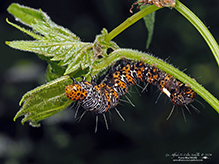 |
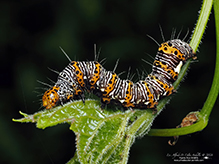 |
|
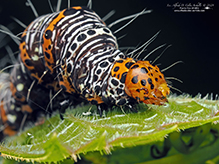 |
||
Babette Kis |
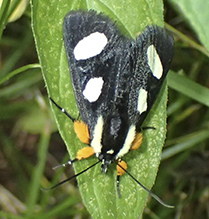 |
Alypia octomaculata 8 spotted forester Alypia octomaculata, eight spotted forester seen at Barnes Prairie hedgerow, Racine Co., Wisconsin June 12, 2021. |
MinnesotaSeasons.com Photos |
||
|
||
|

Slideshows |
|

Visitor Videos |
||
Share your video of this insect. |
||
This button not working for you? |
||
|
Other Videos |
||
Eight spotted Forester Butterfly Alypia octomaculata |
About
Mar 20, 2019 small seldom seem butterfly central Florida USA |
Eight spotted Forester |
About
Apr 19, 2019 Eight-spotted Forester https://www.butterfliesandmoths.org/species/Alypia-octomaculata spotted 4/19/19 |

Visitor Sightings |
||
Report a sighting of this insect. |
||
This button not working for you? |
||
Alfredo Colon |
Location: Albany, NY |
 |
| Babette Kis 6/12/2021 |
Location: Barnes Prairie hedgerow, Racine Co., Wisconsin Alypia octomaculata, eight spotted forester seen at Barnes Prairie hedgerow, Racine Co., Wisconsin June 12, 2021. |
MinnesotaSeasons.com Sightings |
||
|

Created: 1/30/2023 Last Updated: © MinnesotaSeasons.com. All rights reserved. |
